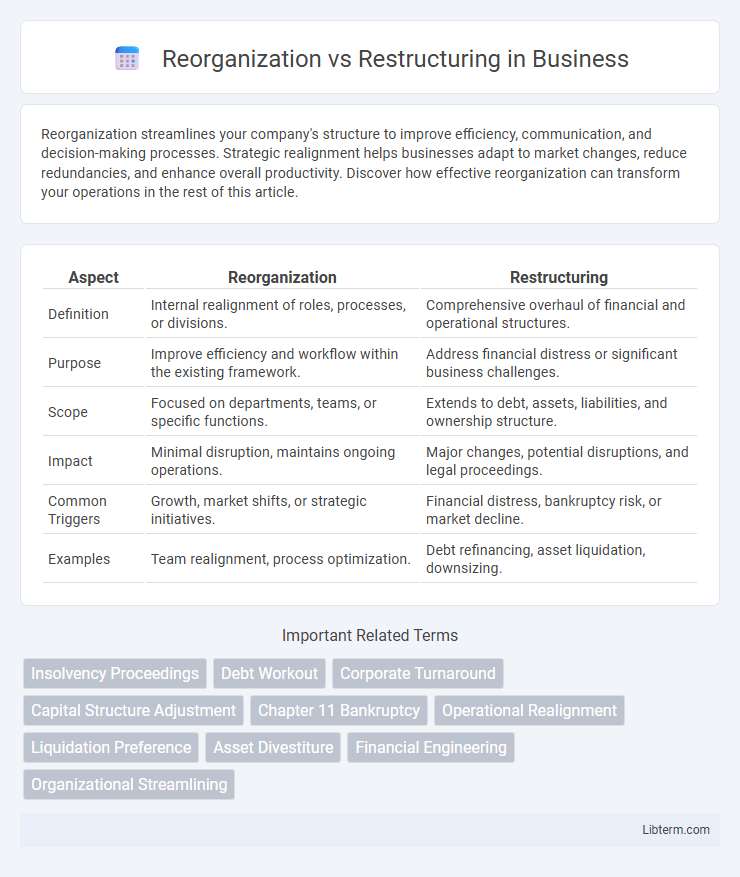Reorganization streamlines your company's structure to improve efficiency, communication, and decision-making processes. Strategic realignment helps businesses adapt to market changes, reduce redundancies, and enhance overall productivity. Discover how effective reorganization can transform your operations in the rest of this article.
Table of Comparison
| Aspect | Reorganization | Restructuring |
|---|---|---|
| Definition | Internal realignment of roles, processes, or divisions. | Comprehensive overhaul of financial and operational structures. |
| Purpose | Improve efficiency and workflow within the existing framework. | Address financial distress or significant business challenges. |
| Scope | Focused on departments, teams, or specific functions. | Extends to debt, assets, liabilities, and ownership structure. |
| Impact | Minimal disruption, maintains ongoing operations. | Major changes, potential disruptions, and legal proceedings. |
| Common Triggers | Growth, market shifts, or strategic initiatives. | Financial distress, bankruptcy risk, or market decline. |
| Examples | Team realignment, process optimization. | Debt refinancing, asset liquidation, downsizing. |
Understanding Reorganization and Restructuring
Reorganization involves altering a company's internal structure to improve efficiency, often through changes in management roles, reporting lines, or operational processes. Restructuring refers to more comprehensive changes, including financial restructuring like debt renegotiation or asset liquidation, aimed at addressing financial challenges or strategic shifts. Understanding the distinctions helps businesses implement targeted strategies to optimize performance and ensure long-term viability.
Key Differences Between Reorganization and Restructuring
Reorganization involves changes to a company's internal structure, such as modifying management hierarchies or workflow processes to improve efficiency, whereas restructuring typically addresses financial and operational challenges by altering debt arrangements or asset portfolios. Reorganization is generally internal and operational, aiming to streamline functions, while restructuring often includes external factors like renegotiating loans or divesting business units. Key differences include scope, with reorganization focusing on organizational design and restructuring targeting financial stability and strategic repositioning.
Common Objectives of Reorganization
Reorganization involves changing the internal structure of a company to improve efficiency, streamline operations, and enhance communication among departments. Common objectives of reorganization include optimizing resource allocation, reducing operational costs, and aligning business processes with strategic goals. This approach ensures better adaptability to market changes and fosters a more agile organizational culture.
Core Goals of Restructuring
Restructuring focuses on improving organizational efficiency by realigning resources, redefining roles, and optimizing processes to enhance financial performance and competitive advantage. It aims to address operational challenges, reduce costs, and adapt to market changes without necessarily altering the company's fundamental purpose. Core goals include streamlining workflows, enhancing stakeholder value, and fostering sustainable growth.
Triggers for Organizational Reorganization
Organizational reorganization is often triggered by shifts in market demand, mergers and acquisitions, or the need to improve operational efficiency. Regulatory changes and technological advancements also serve as catalysts for realigning company structures. Understanding these triggers helps businesses adapt quickly to internal and external pressures, ensuring sustained growth and competitiveness.
When Is Restructuring Necessary?
Restructuring is necessary when a company faces financial distress, operational inefficiencies, or significant market changes that threaten its sustainability. It involves altering the organizational structure, debt arrangements, or operational processes to improve performance and adapt to new business realities. Timely restructuring can prevent bankruptcy, optimize resource allocation, and restore competitive advantage.
Advantages and Challenges of Reorganization
Reorganization offers advantages such as improved efficiency, clearer roles, and enhanced adaptability by realigning company resources and workflows to meet current goals. Challenges of reorganization include employee resistance, potential loss of productivity during transition periods, and the need for effective change management strategies to maintain morale. Successful reorganization balances these benefits and obstacles by fostering communication, training, and strategic planning.
Pros and Cons of Restructuring
Restructuring enhances organizational efficiency by realigning resources and processes to better meet strategic goals, often leading to cost reductions and improved performance. However, it can cause employee uncertainty, disrupt existing workflows, and incur significant implementation expenses. Successful restructuring requires careful planning to balance operational changes with maintaining workforce morale and minimizing business interruptions.
Impact on Employees and Company Culture
Reorganization often leads to changes in roles, reporting lines, and job responsibilities, which can create uncertainty and affect employee morale, while restructuring typically involves deeper shifts such as layoffs or department eliminations, intensifying stress and resistance among staff. Both processes impact company culture by altering communication patterns, collaboration dynamics, and the overall workplace environment, potentially causing disruptions or fostering adaptability depending on execution. Effective change management and transparent communication play critical roles in mitigating negative effects and maintaining a positive organizational culture during these transitions.
Choosing the Right Strategy: Reorganization or Restructuring
Choosing the right strategy between reorganization and restructuring depends on the company's goals and current challenges. Reorganization typically focuses on realigning internal processes and roles to improve efficiency and communication, while restructuring often involves significant changes in financial or operational frameworks to enhance competitiveness or address financial distress. Evaluating the scope of change required and the desired outcome helps determine whether a reorganization or restructuring approach will deliver optimal business performance and long-term sustainability.
Reorganization Infographic

 libterm.com
libterm.com